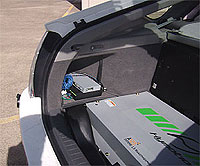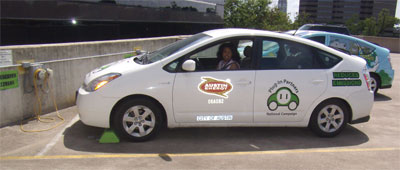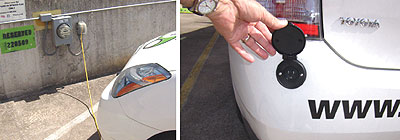![]() Download PDF Version [230 Kb]
Download PDF Version [230 Kb]
![]() Austin Energy Plug-in-Partners Campaign
Austin Energy Plug-in-Partners Campaign
- Plugging the Gaps in Wind Energy
- Put it in Your Garage
- A Green Idea Goes National
- Prototypes Operating Two Years
- The Best is Yet to Come
Plugging the Gaps in Wind Energy
 Figure 1. Wind energy is the fastest growing sector of the U.S. energy mix, and large, modern turbines like the 3-MW models shown here are helping to help drive down costs. However, optimum wind conditions on land normally occur at night, whereas loads tend to peak during the afternoon. That mismatch can be rectified by storing energy produced at night, possibly in the batteries of plug-in hybrid vehicles.
Figure 1. Wind energy is the fastest growing sector of the U.S. energy mix, and large, modern turbines like the 3-MW models shown here are helping to help drive down costs. However, optimum wind conditions on land normally occur at night, whereas loads tend to peak during the afternoon. That mismatch can be rectified by storing energy produced at night, possibly in the batteries of plug-in hybrid vehicles."Wind farms" continue to proliferate in the Midwest and Pacific regions, and they're sprouting up in such unlikely places as upstate New York, central Pennsylvania and northern Arizona. But that's just a drop in the bucket compared with the enormous wind resources soon be developed offshore. In time, the Mid-Atlantic, Gulf and Great Lakes coastlines could become huge producers if everything goes according to plans that are already being drafted. The Department of Energy's National Renewable Energy Laboratory (NREL) foresees 430 gigawatts (GW) of wind energy from continental shelf waters up to 30 m deep using existing technology. Add future mid-depth and deepwater sites and the total peak capacity approaches two terawatts (TW).
Wind energy does have downsides: costs are still high enough to require subsidies; the grid has to be extended to connect wind farms with load centers, and, of course, even the most efficient turbines only produce power when the wind blows. Worse yet, wind velocities at land-based sites tend to peak at night, half-a-day out of synch with peak afternoon loads. That's a crucial imbalance. It can't be avoided, and even utilities that are strongly committed to alternative energy accept wind not as a replacement for fossil fuel plants but as an offset to them.
What can be done - preferably soon and at low cost - with all that "free" and clean off-peak wind energy? Electricity isn't easy or cheap to store…or is it?
Back to TopPut it in Your Garage
The innovative city of Austin and its electric utility, Austin Energy, have what they believe is a practical solution: store the excess night-time wind energy in car batteries. No, not in acres of lead-acid battery farms, but in the batteries of plug-in hybrid electric vehicles. Plug-in hybrids, or PHEVs, are similar to ordinary hybrid cars except that their batteries are large enough to power the vehicles up to 40 miles before recharging. By comparison, conventional hybrids can only operate in full-electric mode for about two miles before the internal combustion engine kicks in.
Here's why the Austin folks believe their idea makes sense:
- They fit our driving patterns. According to Austan Librach, Austin Energy's Director of Emerging Transportation Technologies at the time of this writing, 78% of commuters drive their cars fewer than 40 miles per day, and a PHEV with at least that range is a realistic goal. Automakers are working on it, and General Motors recently announced that a 40-mile Volt PHEV could be available in the 2011 model year. 1
- Recharging stations are everywhere. Current electric vehicles can recharge their batteries quickly from 240-V charging stations, some of which are already operational in California and elsewhere. Commercial PHEVs will probably have that feature, but they will also be rechargeable from the 120-V outlet in their owners' garages ― it'll just take twice as long (about four hours). 2
- They're refreshingly cheap to drive. Mr. Librach calculated that a PHEV's operating costs are equivalent to gasoline costing between about 75 cents to $1.25 per gallon depending on the local utility rate. In Austin, it's about $1.
- They help reduce urban pollution. While it is true that a fossil fuel power plant ultimately has to generate the electricity that charges the PHEV's battery, emissions from that power plant are easier to control and clean up than the exhaust from thousands of cars cruising the city's streets. Power plants are also "point sources" of pollution that can be located far from population centers.
Copper, the Envirometal
What does all this have to do with copper? Quite a bit, actually. Copper plays important roles in all electric vehicle technologies, including PHEVs. It is found in propulsion motors, regenerative braking systems and battery-pack conductors, as well as such traditional applications as electrical and electronic equipment, audio-visual accessories and wiring harnesses Studies have shown that hybrids and PHEVs contain between two-and-a-half and three times the weight of copper as that found their internal combustion engine counterparts. Copper, the envirometal: indispensable for energy production, and just as vital for energy conservation.
A Green Idea Goes National
 Figure 2. Sensors located throughout the PHEV connect to data logger and transmitter in the rear of the vehicle. The system enables Austin Energy engineers to monitor and record operating parameters in real time. The large L5 nanophosphate lithium ion battery seen at the lower right of the photo is manufactured by A123 Systems of Watertown, Massachusetts.
Figure 2. Sensors located throughout the PHEV connect to data logger and transmitter in the rear of the vehicle. The system enables Austin Energy engineers to monitor and record operating parameters in real time. The large L5 nanophosphate lithium ion battery seen at the lower right of the photo is manufactured by A123 Systems of Watertown, Massachusetts.The city council first saw storing wind energy in PHEVs as a means to improve the city's air quality by reducing gasoline use. But it almost immediately recognized that the concept had far-reaching implications for country-wide energy consumption. The result was the formation of Plug-In Partners, a national partnership of local and state governments, utilities, and environmental, consumer and business organizations, all working toward convincing Detroit to produce PHEVs.
It wasn't easy. Austan Librach recalls that "When we began, none of the automakers indicated they had any interest in building a PHEV, so that's what our goal was: to get them started." Using petitions and questionnaires, the PHEV enthusiasts soon showed that a sizeable potential market for the vehicles did exist, and that was enough to change Detroit's mindset. As a result, thousands of Voltand other PHEVs could be humming down America's roads in a few years.
Prototypes Operating Two Years
But how could Austin Energy's engineers be certain their concept would work in the real world? The answer: test it themselves.
 One of Austin Energy's two plug-in hybrid vehicles. The PHEVs are modified versions of the Toyota Prius and are fitted with lithium batteries large enough to extend their all-electric range to 20 miles. One of the utility's conventional Prius hybrids can be seen in the background.
One of Austin Energy's two plug-in hybrid vehicles. The PHEVs are modified versions of the Toyota Prius and are fitted with lithium batteries large enough to extend their all-electric range to 20 miles. One of the utility's conventional Prius hybrids can be seen in the background.Since no commercial PHEVs are yet available, Austin Energy had two of its fleet of Toyota Prius hybrid vehicles modified into plug-ins, Above Image, by the addition of batteries large enough to sustain a charge over approximately 20 miles of driving. Several test batteries have been evaluated, and larger models may be fitted in the future.
Since 2006, the vehicles have been driven daily by Austin Energy employees, mostly around the city and its suburbs, but occasionally as far as Houston, several hundred miles away. For those long trips, the cars operate mostly on engine power, just like a standard Prius.
In order to learn as much as possible about their PHEV prototypes, the utility had the vehicles fitted with a variety of sensors, data-logging equipment and transmitters. This enabled engineers at the company's headquarters to track such parameters as the battery's discharge rate and vehicle performance in various driving modes, all in real time. By all accounts, the two PHEVs perform as well as the company's unmodified Prius hybrids. Fuel economy is improved considerably, as expected, particularly on days when the vehicles are not driven far beyond the batteries' charge limit. In those cases, the cars attain economies greater than 100 miles per gallon.What do Austin Energy employees think of the PHEVs? "I love it!" said Marguerite Jones, the utility's Plug-In Partners Campaign representative and one of the lucky employees who got to drive the cars regularly. Ms. Jones didn't commute in the car since they're recharged in the company's parking garage, Figure 3-left, but she did use the PHEVs in her work in and around the city. The 120-V charging station is equipped with an ordinary watt-meter to monitor operating cost. Except for the meter, which the company uses for internal operations, the station is similar to an ordinary outlet that an owner would have in his or her garage. A standard AWG 12 gage extension cord plugs into a receptacle mounted on the vehicle's rear bumper ( Figure 3-right).
 Figure 3. Austin Energy installed a 120-V charging station and meter on the roof of its parking garage to monitor PHEV energy consumption (left). Note that charging requires only a standard AWG 12 extension cord, which is inserted in a receptacle mounted in the PHEV's rear bumper (right). Charging at 120-V takes about four hours, or about double the time needed with 240 V power.
Figure 3. Austin Energy installed a 120-V charging station and meter on the roof of its parking garage to monitor PHEV energy consumption (left). Note that charging requires only a standard AWG 12 extension cord, which is inserted in a receptacle mounted in the PHEV's rear bumper (right). Charging at 120-V takes about four hours, or about double the time needed with 240 V power.The Best is Yet to Come
Austin Energy's PHEVs are prototypes that were purpose-built using an existing Prius Hybrid body and powertrain. As such, they can't be expected to have the driving range or all of the technical refinements that will be found in a totally new design like the Chevy Volt. When the Volt debuts in the 2011 model year, it and its counterparts from other automakers will undeniably have a positive effect on not just the way we commute, but on amount of gasoline we consume and ― perhaps most important of all ― on the quality of air in our cities.
The Chevy Volt, Coming to Your Garage in 2011
 General Motors has announced that its initial plug-in hybrid, the Chevy Volt, will be available during the 2011 model year. According to the automaker's website, the vehicle is expected to provide 40 miles of all-electric driving using lithium-ion batteries. The car is also equipped with a 1-liter, three-cylinder internal combustion engine which, unlike "conventional" hybrids, provides power to the vehicle's electric generator. The Volt also utilizes regenerative braking to extend all-electric operation. GM claims the car accelerates from full stop to 60 mph in 8.5 seconds and has a maximum speed of 120 mph and a maximum range of 640 miles on a full battery charge and full 12-gal fuel tank.
General Motors has announced that its initial plug-in hybrid, the Chevy Volt, will be available during the 2011 model year. According to the automaker's website, the vehicle is expected to provide 40 miles of all-electric driving using lithium-ion batteries. The car is also equipped with a 1-liter, three-cylinder internal combustion engine which, unlike "conventional" hybrids, provides power to the vehicle's electric generator. The Volt also utilizes regenerative braking to extend all-electric operation. GM claims the car accelerates from full stop to 60 mph in 8.5 seconds and has a maximum speed of 120 mph and a maximum range of 640 miles on a full battery charge and full 12-gal fuel tank.
The Principals
 Austan Librach, P.E., AISC, was Austin Energy's Director, Emerging Transportation Technologies, as which he directed the company's involvement with Plug-In Partners and the modified Prius PHEVs since their inception.
Austan Librach, P.E., AISC, was Austin Energy's Director, Emerging Transportation Technologies, as which he directed the company's involvement with Plug-In Partners and the modified Prius PHEVs since their inception. Marguerite Jones was Austin Energy's representative/coordinator for the Plug-In Partners National Campaign. It was her responsibility to introduce the value of PHEVs to Austin's industrial and commercial community, and to the general public.
Marguerite Jones was Austin Energy's representative/coordinator for the Plug-In Partners National Campaign. It was her responsibility to introduce the value of PHEVs to Austin's industrial and commercial community, and to the general public. Readers seeking technical information regarding Austin Energy's PHEV program can contact Mark Kapner at (512) 322-6123, [email protected]. Mr. Kapner is a Senior Strategy Planner for Austin Energy and a key individual in his company's program to increase alternative energy use dramatically.
Readers seeking technical information regarding Austin Energy's PHEV program can contact Mark Kapner at (512) 322-6123, [email protected]. Mr. Kapner is a Senior Strategy Planner for Austin Energy and a key individual in his company's program to increase alternative energy use dramatically.
Footnotes
-
 See
Chevrolet's website for information about the Chevrolet Volt.
See
Chevrolet's website for information about the Chevrolet Volt. -
 The 120-V charging outlet should be dedicated and be adequately wired and protected for the expected current demand. CDA recommends a dedicated 20-amp circuit.
The 120-V charging outlet should be dedicated and be adequately wired and protected for the expected current demand. CDA recommends a dedicated 20-amp circuit.
